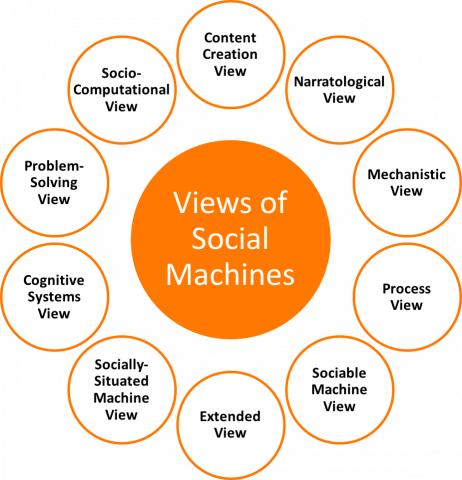This project aims to provide the theoretical foundation for the science of social machines. The theoretical effort comes in the form of five endeavours:
- The Analytic Endeavour: What is a social machine? What is meant by the term “social machine”?
- The Comparative Endeavour: What is it that distinguishes social machines from ostensibly similar systems, such as collective intelligence systems, human computation systems, social computing systems, and so on?
- The Taxonomic Endeavour: What kinds of social machines are there? How should we seek to taxonomize social machines?
- The Interdisciplinary Endeavour: What are the points of theoretical and empirical contact between the science of social machines and other academic disciplines? What forms of interdisciplinary collaboration are likely to be important? What ones are worth pursuing?
- The Methodological Endeavour: What methodological approaches are relevant to the science of social machines? How should social machines be analyzed, modelled, evaluated and engineered?
A crucial part of the Theoretical Frameworks project is to explore the way social machines have been conceptualized across different disciplines (e.g., computer science, cognitive science and social science).
Social machines were originally conceived as systems in which humans do the creative work and machines do the administration. This view, dubbed the content creation view, was first proposed by Berners-Lee and Fischetti in 1999. During the course of the SOCIAM initiative, a variety of other views have come to light. These include the socially-situated machine view, the cognitive systems view, the socio-computational view, the mechanistic view, and so on.
Out of these views, the mechanistic view has proved to be of particular interest. According to the mechanistic view, social machines are viewed as systems whose states, events and processes are realized by socio-technical mechanisms (i.e., mechanisms consisting of human agents and technological components).
One of the virtues of this view is its ability to guide other kinds of theoretical activity (e.g., the comparative and taxonomic and endeavours). The mechanistic view is also compatible with mechanistic approaches in the computational, cognitive and social sciences, and this helps to reveal the nature of the interdisciplinary linkages the connect the science of social machines with other areas of scientific enquiry.




